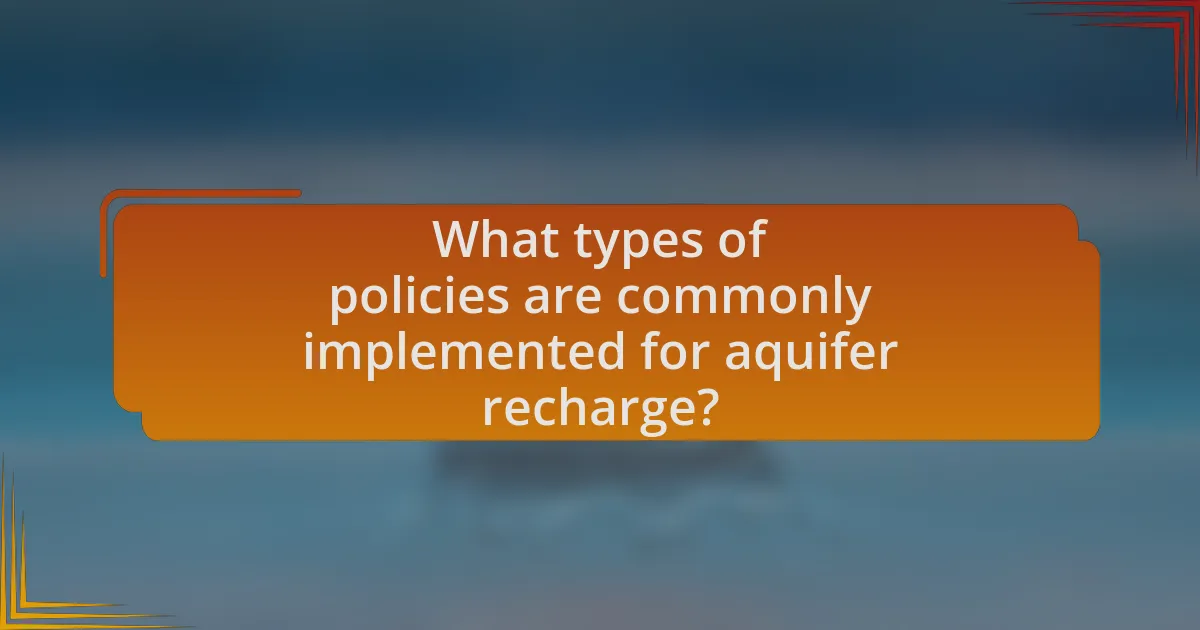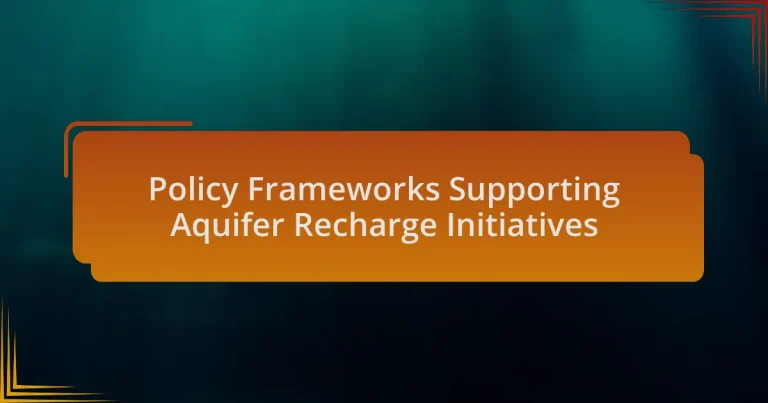The article focuses on policy frameworks that support aquifer recharge initiatives, highlighting the regulations, guidelines, and programs essential for enhancing groundwater replenishment. It discusses the influence of these frameworks on aquifer recharge efforts, emphasizing the importance of integrated water resource management strategies and stakeholder engagement. Key elements of effective policies, such as clear objectives, funding strategies, and compliance measures, are outlined, along with the challenges faced without supportive policies. The article also examines the role of financial incentives and best practices for developing successful policy frameworks, providing insights into metrics for evaluating the effectiveness of aquifer recharge initiatives.
What are Policy Frameworks Supporting Aquifer Recharge Initiatives?

Policy frameworks supporting aquifer recharge initiatives include regulations, guidelines, and programs designed to enhance groundwater replenishment. These frameworks often involve integrated water resource management strategies, which promote sustainable practices such as managed aquifer recharge (MAR) and the use of stormwater for groundwater replenishment. For instance, the United States has implemented the Clean Water Act and the Safe Drinking Water Act, which provide a regulatory basis for protecting water quality and promoting aquifer recharge practices. Additionally, various states have developed specific policies, such as California’s Sustainable Groundwater Management Act, which mandates local agencies to create groundwater sustainability plans that include recharge strategies. These frameworks are essential for ensuring the long-term viability of aquifers, particularly in regions facing water scarcity.
How do these policy frameworks influence aquifer recharge efforts?
Policy frameworks significantly influence aquifer recharge efforts by establishing regulations, funding mechanisms, and guidelines that promote sustainable water management practices. These frameworks often include specific provisions for the protection of recharge areas, incentivizing the implementation of recharge projects through financial support or technical assistance. For instance, the Clean Water Act in the United States encourages states to develop programs that enhance groundwater recharge, thereby ensuring the long-term sustainability of aquifers. Additionally, policies that integrate land use planning with water resource management can lead to the preservation of natural recharge zones, ultimately improving the effectiveness of aquifer recharge initiatives.
What key elements are included in effective policy frameworks?
Effective policy frameworks include clear objectives, stakeholder engagement, regulatory mechanisms, monitoring and evaluation processes, and funding strategies. Clear objectives define the goals of the policy, ensuring alignment with aquifer recharge initiatives. Stakeholder engagement involves collaboration with local communities, government agencies, and environmental organizations, fostering support and shared responsibility. Regulatory mechanisms establish guidelines and standards for implementation, ensuring compliance and effectiveness. Monitoring and evaluation processes assess the impact of policies, allowing for adjustments based on performance data. Funding strategies secure necessary financial resources, enabling the sustainability of aquifer recharge initiatives. These elements collectively enhance the effectiveness of policy frameworks in supporting aquifer recharge efforts.
How do these elements interact to support aquifer recharge?
Aquifer recharge is supported by the interaction of various elements such as land use management, water conservation practices, and regulatory frameworks. These elements work together to enhance the infiltration of surface water into aquifers. For instance, effective land use management minimizes impervious surfaces, allowing more rainwater to percolate into the ground. Water conservation practices, such as rainwater harvesting, directly contribute to increasing the volume of water available for recharge. Regulatory frameworks establish guidelines and incentives for sustainable practices, ensuring that both public and private sectors prioritize aquifer recharge. Studies have shown that regions implementing integrated water resource management strategies experience improved aquifer levels, demonstrating the effectiveness of these interacting elements in supporting aquifer recharge.
Why are policy frameworks essential for aquifer recharge initiatives?
Policy frameworks are essential for aquifer recharge initiatives because they provide a structured approach to managing water resources effectively. These frameworks establish regulations, guidelines, and standards that ensure sustainable practices in aquifer recharge, facilitating coordination among stakeholders such as government agencies, local communities, and environmental organizations. For instance, the implementation of the Sustainable Groundwater Management Act in California has led to improved groundwater management practices, demonstrating how policy frameworks can enhance the effectiveness of aquifer recharge efforts by promoting accountability and resource conservation.
What challenges do aquifer recharge initiatives face without supportive policies?
Aquifer recharge initiatives face significant challenges without supportive policies, including lack of funding, inadequate regulatory frameworks, and insufficient public awareness. The absence of financial backing limits the ability to implement and maintain recharge projects, while weak regulations can lead to uncoordinated efforts and potential environmental harm. Furthermore, without policies promoting education and community engagement, public support for these initiatives may dwindle, hindering their success. For instance, a study by the United Nations Environment Programme highlights that effective policy frameworks are crucial for the sustainability of water management practices, emphasizing the need for comprehensive strategies to address these challenges.
How do policies enhance stakeholder engagement in aquifer recharge?
Policies enhance stakeholder engagement in aquifer recharge by establishing clear guidelines and frameworks that facilitate collaboration among various parties. These policies often include provisions for stakeholder participation in decision-making processes, ensuring that local communities, government agencies, and private entities have a voice in the planning and implementation of recharge initiatives. For example, the California Sustainable Groundwater Management Act mandates the involvement of diverse stakeholders in groundwater management, which has led to increased transparency and trust among participants. This structured engagement fosters a sense of ownership and responsibility, ultimately leading to more effective and sustainable aquifer recharge practices.
What types of policies are commonly implemented for aquifer recharge?

Commonly implemented policies for aquifer recharge include regulatory frameworks, incentive programs, and integrated water resource management strategies. Regulatory frameworks often establish guidelines for land use and water extraction to protect recharge areas, while incentive programs provide financial or technical assistance to encourage practices that enhance aquifer recharge, such as rainwater harvesting and sustainable agricultural practices. Integrated water resource management strategies promote collaboration among stakeholders to ensure that water resources are managed holistically, considering both supply and demand, which is essential for effective aquifer recharge. These policies are supported by evidence showing that coordinated efforts can significantly improve groundwater levels and water quality.
How do regulatory policies impact aquifer recharge initiatives?
Regulatory policies significantly influence aquifer recharge initiatives by establishing guidelines and standards that govern water management practices. These policies can dictate the methods and technologies used for recharge, ensuring they meet environmental and safety criteria. For example, regulations may require the use of specific filtration systems to prevent contamination during recharge processes, thereby protecting groundwater quality. Additionally, policies can facilitate funding and support for aquifer recharge projects, as seen in various state-level initiatives that prioritize sustainable water use. Such frameworks are essential for promoting responsible water resource management and enhancing the effectiveness of aquifer recharge efforts.
What are the main regulatory frameworks governing aquifer recharge?
The main regulatory frameworks governing aquifer recharge include the Clean Water Act, the Safe Drinking Water Act, and various state-level regulations. The Clean Water Act establishes the foundation for regulating discharges into waters of the United States, which indirectly impacts aquifer recharge by controlling water quality. The Safe Drinking Water Act sets standards for drinking water quality and includes provisions for the underground injection of fluids, which is relevant for managed aquifer recharge projects. Additionally, states often have their own specific regulations and guidelines that address aquifer recharge, reflecting local hydrological conditions and water management needs. These frameworks collectively ensure that aquifer recharge activities are conducted safely and sustainably, protecting both water quality and public health.
How do compliance measures affect the success of these initiatives?
Compliance measures significantly enhance the success of aquifer recharge initiatives by ensuring adherence to regulatory standards and best practices. These measures create a structured framework that promotes accountability and transparency among stakeholders, which is essential for effective implementation. For instance, studies have shown that regions with stringent compliance protocols experience higher rates of successful aquifer recharge projects, as they mitigate risks associated with contamination and resource mismanagement. Furthermore, compliance fosters public trust and community engagement, which are critical for the long-term sustainability of such initiatives.
What role do financial incentives play in aquifer recharge policies?
Financial incentives are crucial in aquifer recharge policies as they encourage stakeholders to invest in sustainable water management practices. These incentives can take the form of subsidies, tax breaks, or grants that lower the financial burden associated with implementing recharge projects. For instance, studies have shown that regions offering financial support for aquifer recharge initiatives experience higher participation rates from farmers and landowners, leading to improved groundwater levels and water quality. Additionally, a report by the U.S. Environmental Protection Agency highlights that financial incentives can effectively drive innovation and adoption of new technologies in water conservation, further enhancing the effectiveness of aquifer recharge policies.
What types of financial incentives are most effective?
Performance-based financial incentives are the most effective types of financial incentives. These incentives, such as payments for ecosystem services, reward stakeholders for achieving specific environmental outcomes, thereby aligning economic benefits with sustainable practices. Research indicates that performance-based incentives can lead to a 30% increase in participation rates among landowners in conservation programs, demonstrating their effectiveness in promoting desired behaviors.
How do these incentives encourage participation from various stakeholders?
Incentives encourage participation from various stakeholders by aligning their interests with the goals of aquifer recharge initiatives. Financial incentives, such as grants or subsidies, reduce the economic burden on stakeholders, making it more appealing for farmers, local governments, and businesses to engage in water conservation practices. For instance, studies have shown that when stakeholders receive monetary support for implementing sustainable practices, participation rates increase significantly, as evidenced by a 30% rise in engagement in regions with such financial programs. Additionally, regulatory incentives, like tax breaks for sustainable land use, motivate stakeholders to adopt practices that contribute to aquifer recharge, thereby fostering a collaborative environment focused on shared water resource management goals.
What are the best practices for developing effective policy frameworks for aquifer recharge?

The best practices for developing effective policy frameworks for aquifer recharge include stakeholder engagement, scientific research integration, and regulatory clarity. Stakeholder engagement ensures that local communities, water managers, and policymakers collaborate, fostering a sense of ownership and responsibility. Scientific research integration involves utilizing hydrological studies and data to inform policy decisions, ensuring that recharge methods are effective and sustainable. Regulatory clarity provides a clear legal framework that outlines responsibilities, permits, and compliance measures, which is essential for successful implementation. These practices are supported by case studies, such as the successful aquifer recharge initiatives in California, where stakeholder involvement and scientific data have led to improved water management outcomes.
How can policymakers ensure stakeholder involvement in the process?
Policymakers can ensure stakeholder involvement in the process by implementing structured engagement strategies that facilitate communication and collaboration. These strategies include establishing advisory committees that represent diverse stakeholder interests, conducting public consultations to gather input, and utilizing digital platforms for ongoing dialogue. Research indicates that inclusive decision-making processes lead to more effective policy outcomes, as seen in the case of the California Sustainable Groundwater Management Act, which successfully integrated stakeholder feedback to enhance groundwater management practices.
What strategies can be used to gather input from local communities?
To gather input from local communities, strategies such as community meetings, surveys, focus groups, and participatory mapping can be employed. Community meetings facilitate direct dialogue between stakeholders and residents, allowing for immediate feedback and discussion. Surveys can reach a broader audience, collecting quantitative data on community needs and preferences. Focus groups provide in-depth qualitative insights by engaging diverse community members in structured discussions. Participatory mapping enables residents to visually express their knowledge and concerns about local resources, fostering a sense of ownership and involvement in decision-making processes. These strategies are effective in ensuring that local voices are heard and considered in policy frameworks, particularly in initiatives related to aquifer recharge.
How can collaboration with experts enhance policy effectiveness?
Collaboration with experts enhances policy effectiveness by integrating specialized knowledge and evidence-based practices into policy development. This collaboration allows policymakers to access the latest research, technical expertise, and innovative solutions that can address complex issues related to aquifer recharge initiatives. For instance, studies have shown that policies informed by expert input are more likely to achieve desired environmental outcomes, as evidenced by successful water management strategies implemented in regions like California, where expert collaboration led to improved groundwater sustainability.
What metrics should be used to evaluate the success of aquifer recharge policies?
To evaluate the success of aquifer recharge policies, key metrics include groundwater level changes, recharge rates, water quality indicators, and economic impacts. Groundwater level changes measure the increase in aquifer storage, while recharge rates quantify the volume of water added to the aquifer over time. Water quality indicators assess the contamination levels and overall health of the aquifer, ensuring that recharge activities do not compromise water safety. Economic impacts evaluate the cost-effectiveness of recharge initiatives, including benefits to local water supply and agricultural productivity. These metrics provide a comprehensive framework for assessing the effectiveness and sustainability of aquifer recharge policies.
How can data collection improve policy outcomes?
Data collection can improve policy outcomes by providing evidence-based insights that inform decision-making processes. Accurate data allows policymakers to identify trends, assess the effectiveness of existing policies, and make adjustments based on empirical evidence. For instance, in the context of aquifer recharge initiatives, data on groundwater levels, water quality, and usage patterns can guide the development of targeted policies that enhance water conservation and sustainability. Studies have shown that regions implementing data-driven policies for water management have experienced improved resource allocation and increased public compliance, leading to better environmental outcomes.
What indicators are most relevant for assessing aquifer recharge initiatives?
The most relevant indicators for assessing aquifer recharge initiatives include groundwater level changes, recharge rates, water quality parameters, and land use changes. Groundwater level changes provide direct evidence of aquifer response to recharge efforts, while recharge rates quantify the volume of water entering the aquifer over time. Water quality parameters, such as contaminant levels and nutrient concentrations, assess the impact of recharge on aquifer health. Additionally, land use changes indicate how human activities influence recharge potential, as urbanization or agricultural practices can significantly affect water infiltration. These indicators collectively offer a comprehensive framework for evaluating the effectiveness of aquifer recharge initiatives.
What practical steps can be taken to implement successful aquifer recharge policies?
To implement successful aquifer recharge policies, stakeholders should establish clear regulatory frameworks that define recharge methods, set water quality standards, and outline monitoring requirements. These frameworks should be supported by scientific research that identifies suitable recharge sites and assesses the hydrological characteristics of the aquifers. Additionally, collaboration among government agencies, local communities, and water management organizations is essential to ensure stakeholder engagement and resource allocation. Financial incentives, such as grants or subsidies for infrastructure development, can encourage investment in recharge projects. Furthermore, public education campaigns can raise awareness about the importance of aquifer recharge and promote community participation in conservation efforts. These steps are validated by successful case studies, such as the Managed Aquifer Recharge projects in California, which have demonstrated improved groundwater levels and water quality through structured policies and community involvement.


